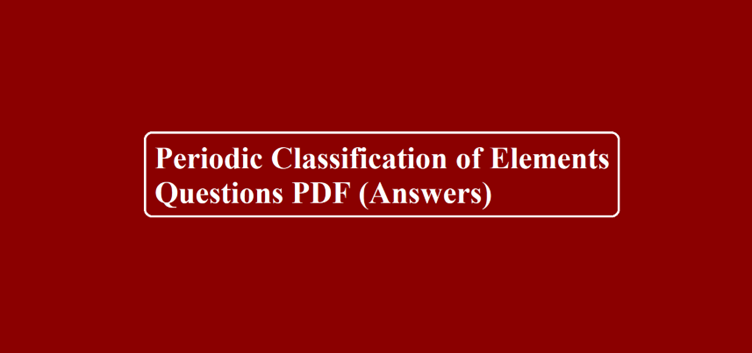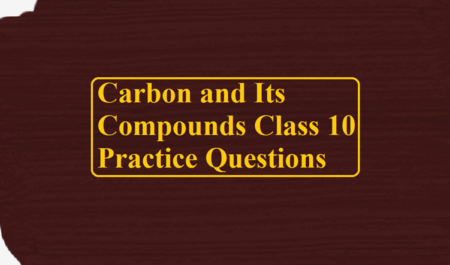Periodic Classification of Elements Questions PDF (Answers)
Periodic Classification of Elements Questions PDF
Ans 1. NaOH > Mg(OH)2 > Al(OH)3. Because the basic strength decreases in a period on moving from left to right.
Ans 2. 2, 8, 6 is the electronic configuration of the element with atomic number 16. It has 6 valence electrons. It belongs to the 16th group and the 3rd period.
Ans 3. (i) Na, Si, and Cl have different properties, therefore they do not form Dobereiner’s triads even though the atomic mass of the middle atom Si (At. Mass – 28) is approximately the average of the atomic masses of Na (At. Mass – 23) and Cl (At. Mass – 35).
Atomic mass of Si = (23 + 35)/2 = 29
ii) Be, Mg, and Ca have many similar properties and also the atomic mass of the middle element Mg is approximately the average of the atomic masses of Be and Ca Be (At. Mass – 9), Mg (At. Mass – 24), Ca (At. Mass – 40),
Atomic mass of Mg = (9 + 40)/2 = 24.5
Ans 4. Increasing order of atomic mass
Ans 5. Eka-aluminium belongs to group 13. Hence, the formula of oxide in group 13 is E2O3.
Ans 6. K > Mg > Al > B. Metallic character increases down the group and decreases along the period.
Ans 7. K will have a more metallic character because it can lose electrons easily due to its bigger atomic size and less effective nuclear charge.
Ans 8. (i) Elements with dissimilar properties were kept in the same group
(ii) Position of Hydrogen was not fixed in the periodic table
(iii) Elements with similar properties were kept in diff groups
(iv) Heavier elements were kept before the lighter elements.
(v) Position of isotopes and isobars could not be explained.
Ans 9. The atomic number of X = Mass number of X – No of neutrons 35 –18 =17
Electronic configuration of X = 2, 8, 7
Group number = 17
Period no = 3 Valency = 8 – 7 = 1
Ans 10. The position of an element depends upon the number of valence electrons which depends upon electronic configuration. Those elements which have the same valence electrons, occupy the same group. Those elements which have one valence electron belong to group 1.
Elements with two valence electrons belong to group 2.
The period number is equal to the number of shells.
If valence electrons are equal to 1, it belongs to group 1. If it has 2 shells, it belongs to the second period. For example, if element ‘X’ has atomic number 11, its electronic configuration is 2, 8,1. It has one valence electron, it belongs to group 1 and it has three shells therefore, it is in the third period.
Periodic Classification of Elements Questions PDF
Ans 11. The electronic configuration of an element X is 2, 8, 6
(a) Since ‘X’ has three energy shells and the period number of an element is equal to the number of energy shells. X belongs to 3rd period.
(b X has 6 valence electrons it belongs to group 16.
(c) Valency will be 2. To acquire a noble gas configuration, it will gain 2 electrons
Ans 12. Co with higher atomic mass proceeds Ni with lower atomic mass. It was solved because Co has a lower atomic number than Ni.
Isotopes should have been given different slots due to different atomic masses, but it is not possible due to the same chemical properties. The problem was solved because isotopes have the same atomic numbers.
Ans 13. Period No. = Number of shells
Group No. = Number of valence electrons + 10.
For Example Na(11): 2, 8,1. It has 1 valence electron, it belongs to group 1. Also, Al (13): 2, 8, 3. It has 3 shells, therefore it belongs to the 3rd period.
Ans 14. a) The electronic configuration of element X with atomic no. 17 is 2, 8, 7. Since it has 7 valence electrons, therefore, it lies in group 17 (10 + 7), Since in element X third shell is being filled, it lies in the third period. X is chlorine. The electronic configuration of Y with atomic number 20 is 2, 8, 8, 2. Since it has 2 valence electrons, it lies in group 2; Y is calcium (Ca)
(b) Since, element X is Cl has seven electrons in the valence shell and needs one more electron to complete its octet. Therefore, it is a non-metal. Further, element Y has two electrons in the valence shell, that can be easily lost to achieve the stable electronic configuration of the nearest inert gas, therefore it is a metal.
(c) Element ‘Y’ is a metal, therefore, its oxide must be basic in nature. Metals and Non-metals form ionic compounds therefore, the bonding in calcium oxide is ionic.
(d) Electronic Configuration of 20Ca = 2,8,8,2 Electronic Configuration of 17Cl = 2,8,7
Ans 15. (i) To study the properties of elements and to keep the elements with similar properties together.
(ii) Chemical properties of elements and atomic number.
(iii) Metals lie on the extreme left, metalloids lie in the middle and non-metals lie on the right side.
(iv) They should be placed in the same slot. Since they have the same numbers of electrons/atomic numbers and the modern periodic table is based on atomic number and not on atomic mass.
Ans 16. (d). Group 16 and Period 3. Non-metals form acidic oxides.
Ans 17. (d) Ca
Ans 18. (A). (d). Element E has the smallest atomic size because moving left to right of a period, atomic size decreases.
(B). (c). The valency of element E is 2 as E belongs to Group 16 and valency in Group 16 is always 2.
(C). (a). Y and Z have similar physical and chemical properties to X.
(D). (b). X has the largest atomic radii. It is because atomic radii decrease from left to right along a period.
Ans 19. (b) X2Y
X = 11 so its electronic configuration will be 2, 8, 1
Y = 8 it’s electronic configuration will be 2, 6
So, the formula is X2Y
Periodic Classification of Elements Questions PDF
Ans 20. (b) L shell. The elements of 2nd period contain two shells, K and L shells.
Assertion Reason
Directions: In the following questions, A statement of Assertion (A) is followed by a statement of Reason (R). Mark the correct choice as.
(a) Both A and R are true and R is the correct explanation of A.
(b) Both A and R are true but R is NOT the correct explanation of A.
(c) A is true but R is false.
(d) A is false and R is true.
Ans 21. (c) A is true but R is false. Dobereiner arranged elements on the basis of increasing atomic weights in a triad
Ans 22. (d) A is false and R is true. The sixth period contains 32 elements and the seventh period is incomplete and like sixth, the period would have 32 elements.
Ans 23. (d) A is false and R is true. Inert gases (noble gases) are least reactive due to stable closed-shell electronic configurations like 1s2 or ns2, np6 (Here n ≤ 2)
Ans 24. (b) Both A and R are true but R is NOT the correct explanation of A.
Be and Al show a diagonal relationship because Be resembles in its properties with Al. The metallic radius of Be (111 pm) is less than the metallic radius of Al (143 pm). Although smaller size is the reason for the anomalous behaviour of Be but not a reason for its diagonal relation with Al.
Ans 25. (d) A is false and R is true. The sixth and seventh period contains 32 elements. Out of 32 elements 14 are lanthanoids in period 6 and actinoids in period 7.
Periodic Classification of Elements Questions PDF
Periodic Classification of Elements Questions
[pdfjs-viewer url=”https://sciencemotive.com/wp-content/uploads/2023/03/Periodic-Classification-of-Elements-Questions.pdf” attachment_id=”4782″ viewer_width=100% viewer_height=800px fullscreen=true download=true print=true]



